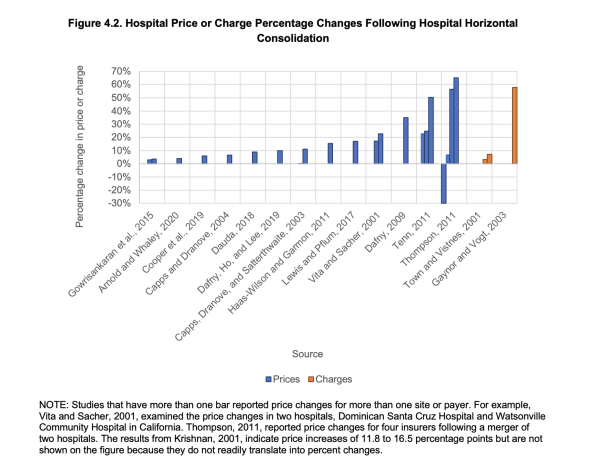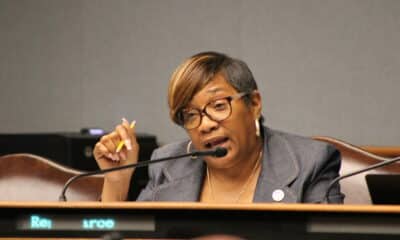Mississippi Today
Mississippi-born dancer comes home with ballet company to share her passion

Mary Kate Shearer’s vision for her future leaped nearly as high as the dancers did that summer afternoon she saw her first ballet onstage. She was only 3 years old, knocking on 4, at the time, and maybe mature enough for a USA International Ballet Competition matinee in her mom’s view.
“I bought tickets way at the back, in case we needed to sneak out,” her mother Janet Shearer recalled. No need, as it turned out. “She was rapt … just so attentive through the whole thing.
“When we walked out of Thalia Mara Hall that afternoon, she looked up and said, ‘Mommy, I want to do that.’”
“Since then, I have not stopped,” Mary Kate Shearer said, “except when injury forced me to.” The young dancer is now a company member of Chattanooga Ballet (CHA Ballet), a small regional company bound for Jackson as part of its Art/Motion tour Friday and Saturday, Jan. 24-25. The homecoming highlights Shearer in performance, with the opportunity, too, to share her newfound love of teaching.
The weekend’s two performances in Jackson showcase works by legends in contemporary ballet — a rare treat for area dance fans — and newer works as well. The flirty, energetic “Tarantella” by New York City Ballet co-founder George Balanchine and the deeply romantic “Sea Shadow” by Joffrey Ballet co-founder Gerald Arpino are key showpieces on a program that also features the new “Intersections of Life” by Dance Theatre of Harlem member Ingrid Silva, and “Copacetic,” a fun and jazzy work choreographed by Chattanooga Ballet Artistic Director Brian McSween. This is CHA Ballet’s 50th anniversary season. Shows will also include contemporary ballet performances by Belhaven University dance students (“In One Accord,” choreographed by Belhaven dance alum Rachel Bitgood) and by Mississippi Metropolitan Ballet (“Timelapse” by Andrew Brader).

Performances will be held at 7:30 p.m. Friday, Jan. 24, and at 2 p.m. Saturday, Jan. 25, at Belhaven University Bitsy Irby Visual Arts and Dance Center’s Studio Theatre.
CHA Ballet’s tour includes master classes for local dance students Saturday morning, with intermediate and advanced sessions for ages 12-15 at 9 a.m. and for advanced students ages 16 and older at 10:30 a.m. Find tickets to CHA Ballet performances and master classes and more information at https://givebutter.com/Belhaven. Advance purchase is recommended; parking is available in the lot behind the building.
The tour’s Jackson leg is sponsored by Janet Shearer Fine Art. “I wanted Mary Kate to come home and dance so that family and friends can see her locally, but more importantly, what Chattanooga Ballet does, serving communities with world-class dance,” Janet Shearer said.
The daughter of Janet and Dale Shearer grew up in Ridgeland, developing the passion she pegged as a pre-schooler through lessons with the Madison-based Mississippi Metropolitan Ballet and summer camp training. Shearer, 26, graduated from Indiana State University and its Jacobs School of Music’s dance department in May 2021 and joined CHA Ballet just months later as one of its seven professional dancers.

“She’s a very determined and dynamic dancer, and highly intelligent,” CHA Ballet CEO/Artistic Director McSween said of Shearer, also praising her range across contemporary, modern and classical works and even character roles. “She’s a great technician. She’s an even better artist.”
“I love to dance and I think it’s incredible that I get to do that as my job,” Shearer said.
When company director McSween floated the possibility of a Jackson tour, she thought it was a fantastic idea.
“That would be so much fun, for a lot of reasons,” she said. “It’ll be really cool because I haven’t had the opportunity to teach in Jackson much at all. … Since I’ve been at Chattanooga Ballet, teaching is a part of my job that I’ve fallen in love with in a way that I didn’t really expect. So, I’m excited to share with my hometown this newfound love of sharing my knowledge about my art form, not just performing.”
In classes, she continues ballet’s strong oral tradition of passing down instruction from one generation to the next. In Chattanooga, she embraces teaching 8-, 9- and 10-year-olds.
“Something about that age group — it’s their first year where they come to ballet twice a week, and they’re not self-conscious yet, so they’re still just so excited and wanting to try new things. It’s just been really cool to share my knowledge with the next generation of future dancers and dance lovers,” Shearer said.
She recalls her own childhood ballet classes at MMB, and some of the imagery MMB Artistic Associate Crystal Skelton used to describe steps.

“It’s still stuff I tell my students now, like talking about our hip bones as the headlights of our car, and making sure they’re staying facing forward all the time at the barre, and things like that,” Shearer said. “Young, young dancers can say, ‘I don’t know what my hip bones are, but I know what the headlights of a car look like.’”
MMB Artistic Director Jennifer Beasley recalled Shearer’s dedication, strong work ethic and her sponge-like eagerness to learn. “I always knew she could have a career in professional ballet if she wanted it. … I’m really excited to see her dance — I haven’t in a little while, and I’m most excited because our students get to meet her and take class and see that dancing professionally is attainable if that is something they want to pursue. Seeing her, being from here and from the school, is going to be great for them.”
Belhaven University Dance Department Chair and Dean of the School of Fine Arts Krista Bower welcomed the opportunity for her students, too, in classes, demonstrations and Q&A with McSween and Shearer. “That’s a great opportunity for the Belhaven dance students to hear about pathways to a professional career, and it’s wonderful for them to get to see a professional dance performance right here in Jackson.”
For Shearer, the tour’s hometown spotlight weaves artistry and memory in a reach back to her roots and a reach out to young dancers who may want to follow in her footsteps. Her self-described strengths and personality that come through in her dance easily trace back to her earliest intro to the art form. “I love to jump , so that’s one thing,” she said with a chuckle. “So, I’m very dynamic in that way.
“I really try and show the audience that I’m up there having fun, and I think that comes through onstage — that I love what I’m doing and I want other people to feel that love, too.”
This article first appeared on Mississippi Today and is republished here under a Creative Commons license.![]()
Mississippi Today
If Tate Reeves calls a tax cut special session, Senate has the option to do nothing

An illness is spreading through the Mississippi Capitol: special session fever.
Speculation is rampant that Gov. Tate Reeves will call a special session if the Senate does not acquiesce to his and the House leadership’s wishes to eliminate the state personal income tax.
Reeves and House leaders are fond of claiming that the about 30% of general fund revenue lost by eliminating the income tax can be offset by growth in other state tax revenue.
House leaders can produce fancy charts showing that the average annual 3% growth rate in state revenue collections can more than offset the revenue lost from a phase out of the income tax.
What is lost in the fancy charts is that the historical 3% growth rate in state revenue includes growth in the personal income tax, which is the second largest source of state revenue. Any growth rate will entail much less revenue if it does not include a 3% growth in the income tax, which would be eliminated if the governor and House leaders have their way. This is important because historically speaking, as state revenue grows so does the cost of providing services, from pay to state employees, to health care costs, to transportation costs, to utility costs and so on.
This does not even include the fact that historically speaking, many state entities providing services have been underfunded by the Legislature, ranging from education to health care, to law enforcement, to transportation. Again, the list goes on and on.
And don’t forget a looming $25 billion shortfall in the state’s Public Employee Retirement System that could create chaos at some point.
But should the Senate not agree to the elimination of the income tax and Reeves calls a special session, there will be tremendous pressure on the Senate leadership, particularly Lt. Gov. Delbert Hosemann, the chamber’s presiding officer.
Generally speaking, a special session will provide more advantages for the eliminate-the-income-tax crowd.
First off, it will be two against one. When the governor and one chamber of the Legislature are on the same page, it is often more difficult for the other chamber to prevail.
The Mississippi Constitution gives the governor sole authority to call a special session and set an agenda. But the Legislature does have discretion in how that agenda is carried out.
And the Legislature always has the option to do nothing during the special session. Simply adjourn and go home is an option.
But the state constitution also says if one chamber is in session, the other house cannot remain out of session for more than three days.
In other words, theoretically, the House and governor working together could keep the Senate in session all year.
In theory, senators could say they are not going to yield to the governor’s wishes and adjourn the special session. But if the House remained in session, the Senate would have to come back in three days. The Senate could then adjourn again, but be forced to come back if the House stubbornly remained in session.
The process could continue all year.
But in the real world, there does not appear to be a mechanism — constitutionally speaking — to force the Senate to come back. The Mississippi Constitution does say members can be “compelled” to attend a session in order to have a quorum, but many experts say that language would not be relevant to make an entire chamber return to session after members had voted to adjourn.
In the past, one chamber has failed to return to the Capitol and suffered no consequences after the other remained in session for more than three days.
As a side note, the Mississippi Constitution does give the governor the authority to end a special session should the two chambers not agree on adjournment. In the early 2000s, then-Gov. Ronnie Musgrove ended a special session when the House and Senate could not agree on a plan to redraw the state’s U.S. House districts to adhere to population shifts found by the U.S. Census.
But would Reeves want to end the special session without approval of his cherished income tax elimination plan?
Probably not.
In 2002 there famously was an 82-day special session to consider proposals to provide businesses more protection from lawsuits. No effort was made to adjourn that session. It just dragged on until the House finally agreed to a significant portion of the Senate plan to provide more lawsuit protection.
In 1969, a special session lasted most of the summer when the Legislature finally agreed to a proposal of then-Gov. John Bell Williams to opt into the federal Medicaid program.
In both those instances, those wanting something passed — Medicaid in the 1960s and lawsuit protections in the 2000s — finally prevailed.
This article first appeared on Mississippi Today and is republished here under a Creative Commons license.![]()
Mississippi Today
On this day in 1898

Feb. 22, 1898

Frazier Baker, the first Black postmaster of the small town of Lake City, South Carolina, and his baby daughter, Julia, were killed, and his wife and three other daughters were injured when a lynch mob attacked.
When President William McKinley appointed Baker the previous year, local whites began to attack Baker’s abilities. Postal inspectors determined the accusations were unfounded, but that didn’t halt those determined to destroy him.
Hundreds of whites set fire to the post office, where the Bakers lived, and reportedly fired up to 100 bullets into their home. Outraged citizens in town wrote a resolution describing the attack and 25 years of “lawlessness” and “bloody butchery” in the area.
Crusading journalist Ida B. Wells wrote the White House about the attack, noting that the family was now in the Black hospital in Charleston “and when they recover sufficiently to be discharged, they) have no dollar with which to buy food, shelter or raiment.
McKinley ordered an investigation that led to charges against 13 men, but no one was ever convicted. The family left South Carolina for Boston, and later that year, the first nationwide civil rights organization in the U.S., the National Afro-American Council, was formed.
In 2019, the Lake City post office was renamed to honor Frazier Baker.
“We, as a family, are glad that the recognition of this painful event finally happened,” his great-niece, Dr. Fostenia Baker said. “It’s long overdue.”
This article first appeared on Mississippi Today and is republished here under a Creative Commons license.![]()
Mississippi Today
Memorial Health System takes over Biloxi hospital, what will change?

by Justin Glowacki with contributions from Rasheed Ambrose, Javion Henry, McKenna Klamm, Matt Martin and Aidan Tarrant
BILOXI – On Feb. 1, Memorial Health System officially took over Merit Health Biloxi, solidifying its position as the dominant healthcare provider in the region. According to Fitch Ratings, Memorial now controls more than 85% of the local health care market.
This isn’t Memorial’s first hospital acquisition. In 2019, it took over Stone County Hospital and expanded services. Memorial considers that transition a success and expects similar results in Biloxi.
However, health care experts caution that when one provider dominates a market, it can lead to higher prices and fewer options for patients.
Expanding specialty care and services

One of the biggest benefits of the acquisition, according to Kristian Spear, the new administrator of Memorial Hospital Biloxi, will be access to Memorial’s referral network.
By joining Memorial’s network, Biloxi patients will have access to more services, over 40 specialties and over 100 clinics.
“Everything that you can get at Gulfport, you will have access to here through the referral system,” Spear said.
One of the first improvements will be the reopening of the Radiation Oncology Clinic at Cedar Lake, which previously shut down due to “availability shortages,” though hospital administration did not expand on what that entailed.
“In the next few months, the community will see a difference,” Spear said. “We’re going to bring resources here that they haven’t had.”
Beyond specialty care, Memorial is also expanding hospital services and increasing capacity. Angela Benda, director of quality and performance improvement at Memorial Hospital Biloxi, said the hospital is focused on growth.
“We’re a 153-bed hospital, and we average a census of right now about 30 to 40 a day. It’s not that much, and so, the plan is just to grow and give more services,” Benda said. “So, we’re going to expand on the fifth floor, open up more beds, more admissions, more surgeries, more provider presence, especially around the specialties like cardiology and OB-GYN and just a few others like that.”
For patient Kenneth Pritchett, a Biloxi resident for over 30 years, those changes couldn’t come soon enough.

Pritchett, who was diagnosed with congestive heart failure, received treatment at Merit Health Biloxi. He currently sees a cardiologist in Cedar Lake, a 15-minute drive on the interstate. He says having a cardiologist in Biloxi would make a difference.
“Yes, it’d be very helpful if it was closer,” Pritchett said. “That’d be right across the track instead of going on the interstate.”
Beyond specialty services and expanded capacity, Memorial is upgrading medical equipment and renovating the hospital to improve both function and appearance. As far as a timeline for these changes, Memorial said, “We are taking time to assess the needs and will make adjustments that make sense for patient care and employee workflow as time and budget allow.”
Unanswered questions: insurance and staffing
As Memorial Health System takes over Merit Health Biloxi, two major questions remain:
- Will patients still be covered under the same insurance plans?
- Will current hospital staff keep their jobs?
Insurance Concerns
Memorial has not finalized agreements with all insurance providers and has not provided a timeline for when those agreements will be in place.
In a statement, the hospital said:
“Memorial recommends that patients contact their insurance provider to get their specific coverage questions answered. However, patients should always seek to get the care they need, and Memorial will work through the financial process with the payers and the patients afterward.”
We asked Memorial Health System how the insurance agreements were handled after it acquired Stone County Hospital. They said they had “no additional input.”
What about hospital staff?
According to Spear, Merit Health Biloxi had around 500 employees.
“A lot of the employees here have worked here for many, many years. They’re very loyal. I want to continue that, and I want them to come to me when they have any concerns, questions, and I want to work with this team together,” Spear said.
She explained that there will be a 90-day transitional period where all employees are integrated into Memorial Health System’s software.
“Employees are not going to notice much of a difference. They’re still going to come to work. They’re going to do their day-to-day job. Over the next few months, we will probably do some transitioning of their computer system. But that’s not going to be right away.”
The transition to new ownership also means Memorial will evaluate how the hospital is operated and determine if changes need to be made.
“As we get it and assess the different workflows and the different policies, there will be some changes to that over time. Just it’s going to take time to get in here and figure that out.”
During this 90-day period, Erin Rosetti, Communications Manager at Memorial Health System said, “Biloxi employees in good standing will transition to Memorial at the same pay rate and equivalent job title.”
Kent Nicaud, President and CEO of Memorial Health System, said in a statement that the hospital is committed to “supporting our staff and ensuring they are aligned with the long-term vision of our health system.”
What research says about hospital consolidations
While Memorial is promising improvements, larger trends in hospital mergers raise important questions.
Research published by the Rand Corporation, a nonprofit, nonpartisan research organization, found that research into hospital consolidations reported increased prices anywhere from 3.9% to 65%, even among nonprofit hospitals.

The impact on patient care is mixed. Some studies suggest merging hospitals can streamline services and improve efficiency. Others indicate mergers reduce competition, which can drive up costs without necessarily improving care.
When asked about potential changes to the cost of care, hospital leaders declined to comment until after negations with insurance companies are finalized, but did clarify Memorial’s “prices are set.”
“We have a proven record of being able to go into institutions and transform them,” said Angie Juzang, Vice President of Marketing and Community Relations at Memorial Health System.
When Memorial acquired Stone County Hospital, it expanded the emergency room to provide 24/7 emergency room coverage and renovated the interior.
When asked whether prices increased after the Stone County acquisition, Memorial responded:
“Our presence has expanded access to health care for everyone in Stone County and the surrounding communities. We are providing quality healthcare, regardless of a patient’s ability to pay.”
The response did not directly address whether prices went up — leaving the question unanswered.
The bigger picture: Hospital consolidations on the rise
According to health care consulting firm Kaufman Hall, hospital mergers and acquisitions are returning to pre-pandemic levels and are expected to increase through 2025.
Hospitals are seeking stronger financial partnerships to help expand services and remain stable in an uncertain health care market.

Source: Kaufman Hall M&A Review
Proponents of hospital consolidations argue mergers help hospitals operate more efficiently by:
- Sharing resources.
- Reducing overhead costs.
- Negotiating better supply pricing.
However, opponents warn few competitors in a market can:
- Reduce incentives to lower prices.
- Slow wage increases for hospital staff.
- Lessen the pressure to improve services.
Leemore Dafny, PhD, a professor at Harvard and former deputy director for health care and antitrust at the Federal Trade Commission’s Bureau of Economics, has studied hospital consolidations extensively.
In testimony before Congress, she warned: “When rivals merge, prices increase, and there’s scant evidence of improvements in the quality of care that patients receive. There is also a fair amount of evidence that quality of care decreases.”
Meanwhile, an American Hospital Association analysis found consolidations lead to a 3.3% reduction in annual operating expenses and a 3.7% reduction in revenue per patient.
This article first appeared on Mississippi Today and is republished here under a Creative Commons license.![]()
-

 News from the South - Louisiana News Feed2 days ago
News from the South - Louisiana News Feed2 days agoJeff Landry’s budget includes cuts to Louisiana’s domestic violence shelter funding
-

 News from the South - North Carolina News Feed6 days ago
News from the South - North Carolina News Feed6 days agoModest drops in some North Carolina prices under Trump | North Carolina
-

 News from the South - North Carolina News Feed2 days ago
News from the South - North Carolina News Feed2 days agoBills from NC lawmakers expand gun rights, limit cellphone use
-

 News from the South - Arkansas News Feed6 days ago
News from the South - Arkansas News Feed6 days agoTiming out the incoming winter weather
-

 News from the South - Oklahoma News Feed5 days ago
News from the South - Oklahoma News Feed5 days agoRemains of Aubrey Dameron found, family gathers in her honor
-

 News from the South - Florida News Feed6 days ago
News from the South - Florida News Feed6 days agoExpert discusses how deportations could cause labor shortages for several industries
-

 News from the South - South Carolina News Feed6 days ago
News from the South - South Carolina News Feed6 days agoSC Flu cases on the rise: Prisma Health Doctors speak out on how to spot symptoms, get treatment
-

 Mississippi Today6 days ago
Mississippi Today6 days agoMississippi could face health research funding cuts under Trump administration policy











































